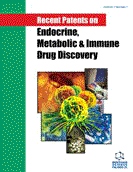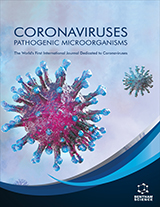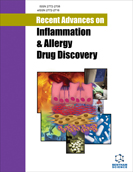Abstract
Background: The blood in the umbilical cord that provides the connection between mother and fetus during pregnancy is called cord blood. The blood of umbilical cord which is usually got rid of following birth, is a very rich stem cell source.
Objective: Cord blood collection gives no harm to the mother and baby. Besides, its allogeneic and autologous usage, the most important disadvantage is that the number of cells is insufficient in adults.
Conclusion: Today, it is predominantly used for therapeutic purposes for many diseases. The aim of this review is giving a detailed information about groups of stem cells in cord blood and determining the point of clinical use.
Keywords: Clinical use, cord blood, stem cell, umblical cord blood, patent, haematology, haemopoetic diseases.
Recent Patents on Endocrine, Metabolic & Immune Drug Discovery (Discontinued)
Title:Clinical Use and Patentability of Cord Blood
Volume: 11 Issue: 1
Author(s): Turker Cavusoglu*, Kubilay Dogan Kilic, Gurkan Yigitturk, Canberk Tomruk, Mehmet Turgut and Yigit Uyanikgil
Affiliation:
- Department of Histology and Embryology, Ege University School of Medicine, Izmir,Turkey
Keywords: Clinical use, cord blood, stem cell, umblical cord blood, patent, haematology, haemopoetic diseases.
Abstract: Background: The blood in the umbilical cord that provides the connection between mother and fetus during pregnancy is called cord blood. The blood of umbilical cord which is usually got rid of following birth, is a very rich stem cell source.
Objective: Cord blood collection gives no harm to the mother and baby. Besides, its allogeneic and autologous usage, the most important disadvantage is that the number of cells is insufficient in adults.
Conclusion: Today, it is predominantly used for therapeutic purposes for many diseases. The aim of this review is giving a detailed information about groups of stem cells in cord blood and determining the point of clinical use.
Export Options
About this article
Cite this article as:
Cavusoglu Turker *, Kilic Dogan Kubilay , Yigitturk Gurkan , Tomruk Canberk , Turgut Mehmet and Uyanikgil Yigit , Clinical Use and Patentability of Cord Blood, Recent Patents on Endocrine, Metabolic & Immune Drug Discovery (Discontinued) 2017; 11 (1) . https://dx.doi.org/10.2174/1872214812666180314121241
| DOI https://dx.doi.org/10.2174/1872214812666180314121241 |
Print ISSN 1872-2148 |
| Publisher Name Bentham Science Publisher |
Online ISSN 2212-3334 |
 22
22 3
3Related Articles
-
Regulation of Adrenomedullin and its Family Peptide by RAMP System – Lessons from Genetically Engineered Mice
Current Protein & Peptide Science The Rise of Carbapenem-Resistant Acinetobacter baumannii
Current Pharmaceutical Design The Implications of Sortilin/Vps10p Domain Receptors in Neurological and Human Diseases
CNS & Neurological Disorders - Drug Targets Vildagliptin Restores Renal Myogenic Function and Attenuates Renal Sclerosis Independently of Effects on Blood Glucose or Proteinuria in Zucker Diabetic Fatty Rat
Current Vascular Pharmacology Withanolides: Biologically Active Constituents in the Treatment of Alzheimer’s Disease
Medicinal Chemistry Transient Receptor Potential Vanilloid 1 Channel Modulation: A Novel Approach to Pain Therapy
Current Bioactive Compounds Targeting Receptor Tyrosine Kinase Pathways in Hepatocellular Carcinoma
Anti-Cancer Agents in Medicinal Chemistry Obesity and Arterial Compliance Alterations
Current Vascular Pharmacology WISP1 (CCN4) Autoregulates its Expression and Nuclear Trafficking of β-Catenin during Oxidant Stress with Limited Effects upon Neuronal Autophagy
Current Neurovascular Research Editorial [Hot Topic: Sepsis (Guest Editor: David E. Joyce)]
Current Drug Targets Use of Antihistamines in Ocular Therapy
Current Medicinal Chemistry - Anti-Inflammatory & Anti-Allergy Agents An Overview of the Effect of Weight Loss on Cardiovascular Autonomic Function
Current Diabetes Reviews G Protein Coupled Receptors as Drug Targets: The Role of β-Arrestins
Endocrine, Metabolic & Immune Disorders - Drug Targets Homeobox Genes and Human Genetic Disorders
Current Molecular Medicine The “Sympathetic” Kidney: Multiples Effects of Renal Sympathetic Nerve Ablation
Current Hypertension Reviews Insight to the Pathophysiology of Stable Angina Pectoris
Current Pharmaceutical Design Advances in the Treatment of Neurodegenerative Disorders Employing Nanoparticles
Recent Patents on Drug Delivery & Formulation RNA Splicing Manipulation: Strategies to Modify Gene Expression for a Variety of Therapeutic Outcomes
Current Gene Therapy Momordicacharantia: A New Strategic Vision to Improve the Therapy of Endoplasmic Reticulum Stress
Current Pharmaceutical Design Caffeic Acid Phenethyl Ester Restores Adipocyte Gene Profile Expression Following Lipopolysaccharide Treatment
Letters in Drug Design & Discovery






















